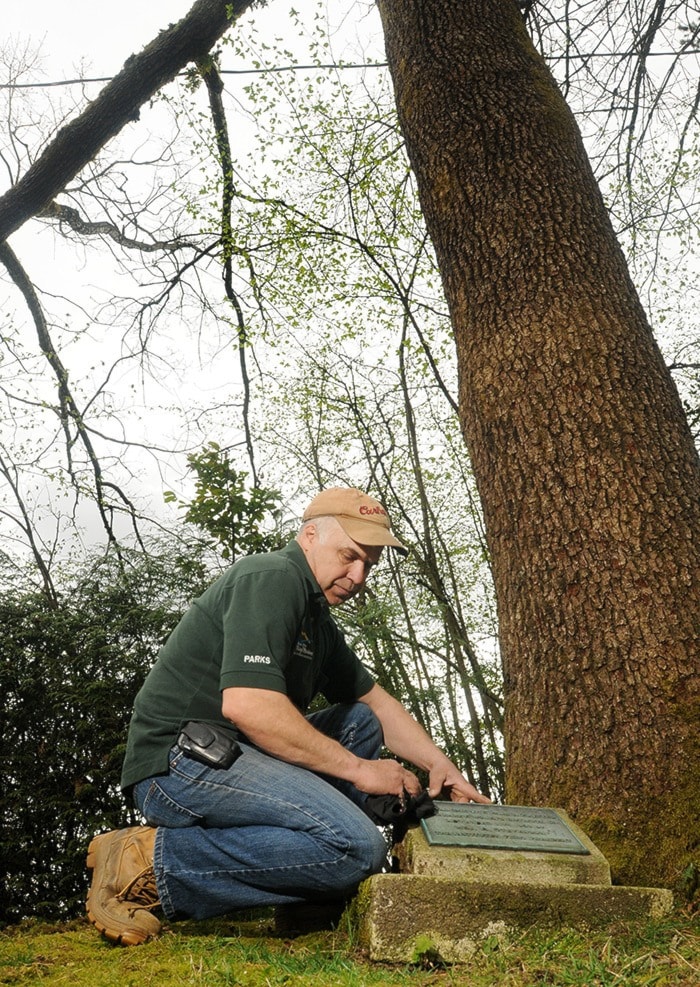In the new part of Maple Ridge Cemetery, not far from the awkwardly-placed English oak tree, a newer grove of spindly young oaks almost form a circle.
The seeds, likely carried there by industrious squirrels whose dining habits created the geometric shape, have created a spot where tree tops could weave together above, creating a canopy, and a sheltered space below, perfect for peace and reflection.
It’s possible, though nothing’s been decided, that the oak grove could form a scattering garden where the ashes of loved ones are left to the ages.
“This is something we haven’t determined yet. It’s quite a lovely little area and it has quite a nice memorial feel to it,” park planner Sylvia Pendl told council Monday.
The oak grove, which used to be on a private lot, is now part of an expansion of the burial grounds currently underway, to keep pace with the growth of Maple Ridge.
After acquiring two properties to the west, on Dewdney Trunk Road, about .65 acres each, there are now another 1.3 acres of additional burial space to add to the existing six acres.
“Space is filling up. The community has grown significantly,” Pendl added later.
Clearing those two new properties has occurred, in preparation for plowing, grading and seeding the new property. Following that, drainage issues will be dealt with and the land will settle before it’s used for burials in several years’ time.
A separate parcel of land that remains in private ownership separates the two new sections, requiring two entrances off Dewdney Trunk Road.
Pendl told council that houses were taken down and the land cleared to minimize use of the property as a dump site or as a hangout for the homeless.
Most of the trees that were cleared away were fruit trees planted by previous generations.
But no decisions have been made and designing the expansion is just beginning.
“This something we haven’t determined yet.”
Given current trends, however, the cemetery will be able to accommodate more remains than in its previous two centuries. More people are choosing cremation then burial, rather than full burials. A plot for cremated remains for residents of Maple Ridge costs $1,157, while a full-sized plot is $5,349.
In 2006, 87 per cent of burials were for cremated remains, while only 13 per cent were for full burials, Pendl noted.
According to the 2008 Cemetery Master Plan, another acre of land will still be needed by 2025.
That could happen if the district acquires the other vacant lot, which now separates the two new sections on Dewdney Trunk Road.
Maple Ridge Cemetery is built based on the designs and tastes of pioneers.
According to the district’s website, its design harkens back to the Romanticism of the 19th century, and features open spaces and panoramic views.
The cemetery was established in the 1880s, after Maple Ridge’s incorporation in 1874. Within its boundaries are Thomas Haney and family, along with William Nelson, the original owner of the property, and his Kanaka (Hawaiian) wife. John McIver, who organized the first meeting of the District of Maple Ridge, and J. Inouye, pioneer of the Japanese community in Maple Ridge, are also buried there.
The English oak tree marks the entrance to the cemetery, although two huge maple trees provide the most impressive views, framing the roadway that leads between the markers.
The English oak was planted on Remembrance Day 1938, a year before the start of the Second World War, by the Haney Women’s Institute.
“A cemetery is a form of archive,” said Val Patenaude, director with the Maple Ridge Museum.
History can be followed by noting who was buried there and who isn’t. For instance, many Japanese grave markers from before the Second World War are visible. After the war and the deportations of Japanese families inland, those names weren’t as visible.
Patenaude said the museum can lend a book to serve as a guide for a tour of the cemetery.
She’s worried, though, about society’s recent trend to avoid memorial services, funerals or burials in favour of more informal services and burial. That can lead to lapses in historical records as families and individuals vanish from history.
